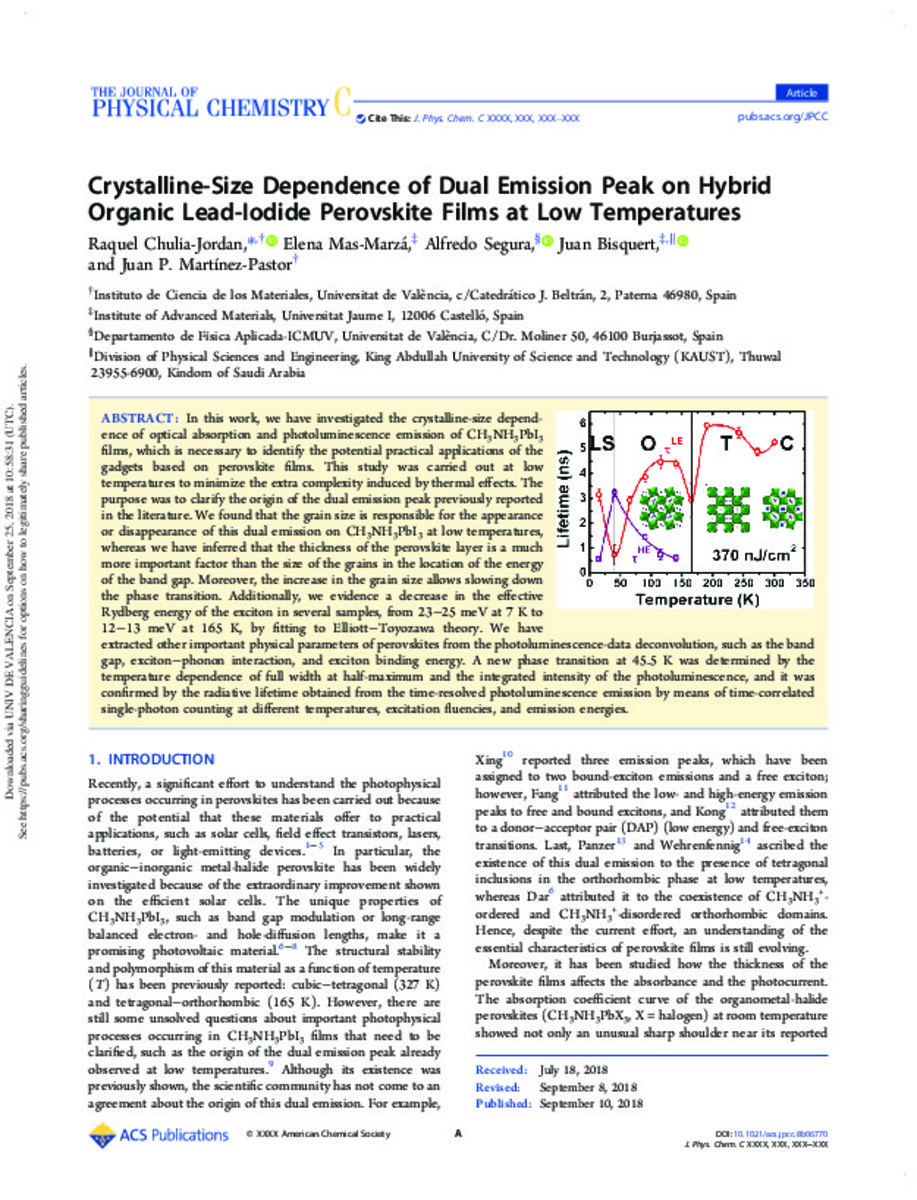Mostrar el registro sencillo del ítem
Crystalline-Size Dependence of Dual Emission Peak on Hybrid Organic Lead-Iodide Perovskite Films at Low Temperatures
| dc.contributor.author | Chulia-Jordan, Raquel | |
| dc.contributor.author | Mas, Elena | |
| dc.contributor.author | Segura, Alfredo | |
| dc.contributor.author | Bisquert, Juan | |
| dc.contributor.author | Martínez-Pastor, Juan P. | |
| dc.date.accessioned | 2019-03-01T10:26:37Z | |
| dc.date.available | 2019-03-01T10:26:37Z | |
| dc.date.issued | 2018-09 | |
| dc.identifier.citation | CHULIA-JORDAN, Raquel, et al. Crystalline-Size Dependence of Dual Emission Peak on Hybrid Organic Lead-Iodide Perovskite Films at Low Temperatures. The Journal of Physical Chemistry C, 2018, 122.39: 22717-22727. | ca_CA |
| dc.identifier.uri | http://hdl.handle.net/10234/181615 | |
| dc.description.abstract | In this work, we have investigated the crystalline-size dependence of optical absorption and photoluminescence emission of CH3NH3PbI3 films, which is necessary to identify the potential practical applications of the gadgets based on perovskite films. This study was carried out at low temperatures to minimize the extra complexity induced by thermal effects. The purpose was to clarify the origin of the dual emission peak previously reported in the literature. We found that the grain size is responsible for the appearance or disappearance of this dual emission on CH3NH3PbI3 at low temperatures, whereas we have inferred that the thickness of the perovskite layer is a much more important factor than the size of the grains in the location of the energy of the band gap. Moreover, the increase in the grain size allows slowing down the phase transition. Additionally, we evidence a decrease in the effective Rydberg energy of the exciton in several samples, from 23–25 meV at 7 K to 12–13 meV at 165 K, by fitting to Elliott–Toyozawa theory. We have extracted other important physical parameters of perovskites from the photoluminescence-data deconvolution, such as the band gap, exciton–phonon interaction, and exciton binding energy. A new phase transition at 45.5 K was determined by the temperature dependence of full width at half-maximum and the integrated intensity of the photoluminescence, and it was confirmed by the radiative lifetime obtained from the time-resolved photoluminescence emission by means of time-correlated single-photon counting at different temperatures, excitation fluencies, and emission energies. | ca_CA |
| dc.format.extent | 10 p. | ca_CA |
| dc.format.mimetype | application/msword | ca_CA |
| dc.language.iso | eng | ca_CA |
| dc.publisher | American Chemical Society | ca_CA |
| dc.rights | Copyright © 2018 American Chemical Society | ca_CA |
| dc.rights.uri | http://rightsstatements.org/vocab/InC/1.0/ | * |
| dc.subject | perovskite | ca_CA |
| dc.subject | solar cells | ca_CA |
| dc.subject | temperature dependence | ca_CA |
| dc.subject | binding energy | ca_CA |
| dc.subject | crystalline materials | ca_CA |
| dc.subject | energy gap | ca_CA |
| dc.subject | excitons | ca_CA |
| dc.subject | grain size and shape | ca_CA |
| dc.subject | iodine compounds | ca_CA |
| dc.subject | layered semiconductors | ca_CA |
| dc.subject | light absorption | ca_CA |
| dc.subject | particle beams | ca_CA |
| dc.subject | photoluminescence | ca_CA |
| dc.subject | semiconductor quantum wells | ca_CA |
| dc.title | Crystalline-Size Dependence of Dual Emission Peak on Hybrid Organic Lead-Iodide Perovskite Films at Low Temperatures | ca_CA |
| dc.type | info:eu-repo/semantics/article | ca_CA |
| dc.identifier.doi | http://dx.doi.org/10.1021/acs.jpcc.8b06770 | |
| dc.relation.projectID | European Union’s Horizon 2020 research and innovation programme Marie Sklodowska-Curie (grant agreement no. 704998 (R.C.J.)) ; Ministerio de Economía y Competitividad (MINECO) from Spain (projectsMAT2013-47192-C3-1-R, TEC2014-53727-C2-1-R and TEC2017-86102-02-1-R) | ca_CA |
| dc.rights.accessRights | info:eu-repo/semantics/openAccess | ca_CA |
| dc.relation.publisherVersion | https://pubs.acs.org/doi/abs/10.1021/acs.jpcc.8b06770 | ca_CA |
| dc.date.embargoEndDate | 2019-09-10 | |
| dc.type.version | info:eu-repo/semantics/acceptedVersion | ca_CA |
Ficheros en el ítem
Este ítem aparece en la(s) siguiente(s) colección(ones)
-
INAM_Articles [531]







